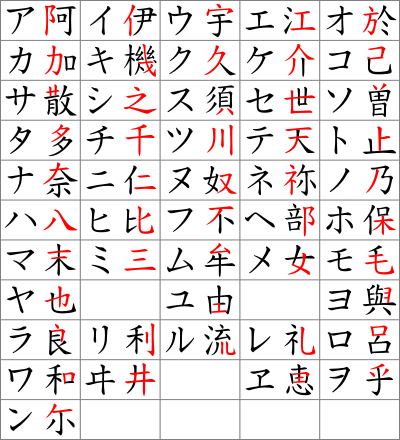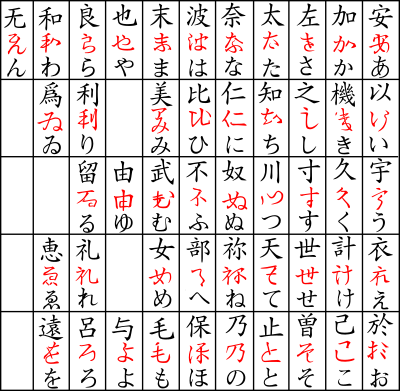Man'yōgana facts for kids
Quick facts for kids Man'yōgana万葉仮名 |
|
|---|---|

Katakana characters and the man'yōgana they originated from
|
|
| Type | Syllabary |
| Spoken languages | Japanese and Okinawan |
| Time period | c. 650 CE to Meiji era |
| Parent systems |
Oracle bone script
|
| Child systems | Hiragana, Katakana |
| Sister systems | Contemporary kanji |
| Note: This page may contain IPA phonetic symbols in Unicode. | |
Man'yōgana (error: {{nihongo}}: Japanese or romaji text required (help)) is an old writing system from Japan. It used Chinese characters to write the sounds of the Japanese language. This was the first known system to use characters just for their sounds in Japanese.
We don't know exactly when man'yōgana first appeared. But we know it was used at least by the mid-7th century. The name "man'yōgana" comes from the Man'yōshū. This is a famous collection of Japanese poetry from the Nara period. It was written using man'yōgana.
Sometimes, texts using this system also used Chinese characters for their meaning. But man'yōgana specifically means when these characters were used only for their sound. The sounds often came from how Chinese characters were pronounced in China at that time. However, sometimes they used Japanese readings of the characters too. For example, the character 木 means 'tree'. It could be used for the sound /mo/ (from Chinese) or /ko/ or /kwi/ (from Old Japanese for 'tree').
Later on, simpler versions of man'yōgana became the hiragana and katakana scripts. These are the writing systems used in modern Japanese today.
Contents
How Man'yōgana Started
One of the oldest possible examples of man'yōgana is on the iron Inariyama Sword. This sword was found in 1968. In 1978, scientists used X-rays to look at it closely. They found a gold writing with at least 115 Chinese characters. This writing included Japanese personal names that seemed to be written using sounds. People think this sword was made around the year 471 A.D. It's possible the writing on the sword was in a Chinese language used in the Korean kingdom of Baekje.
How Man'yōgana Worked
Man'yōgana used kanji (Chinese characters) for their sounds, not their meanings. Imagine using the letter 'C' for the sound 'see', not for the meaning of the letter itself. There wasn't one strict way to choose which kanji to use. Different kanji could stand for the same sound. The writer just picked whichever one they liked. By the end of the 8th century, about 970 kanji were used to write the 90 different sounds in Japanese.
For example, here is a part of a poem from the Man'yōshū:
| Man'yōgana | 之乎路可良 | 多太古要久礼婆 | 波久比能海 | 安佐奈藝思多理 | 船梶母我毛 |
|---|---|---|---|---|---|
| Katakana | シオジカラ | タダコエクレバ | ハクヒノウミ | アサナギシタリ | フネカジモガモ |
| Modern | 志雄路から | ただ越え来れば | 羽咋の海 | 朝凪したり | 船梶もがも |
| Romanized | Shioji kara | tadakoe kureba | Hakuhi no umi | asanagi shitari | funekaji mogamo |
In this poem, the sounds mo (母, 毛) and shi (之, 思) are written with different characters. This shows how flexible the system was. Many words were written only by their sounds. But some words, like ji (路), umi (海), and funekaji (船梶), were written using characters for their meaning.
Sometimes, certain sounds in specific words were always written with the same characters. This helped language experts understand how old Japanese sounds might have changed over time.
Different Ways of Using Man'yōgana
Man'yōgana characters were used in a few different ways to represent sounds.
- Shakuon kana (借音仮名): These characters were used for their Chinese-based pronunciation. One character could stand for one or two sounds.
- Shakkun kana (借訓仮名): These characters were used for their native Japanese pronunciation. One to three characters could stand for one to three sounds.
How Man'yōgana Developed into Hiragana and Katakana
Japanese is a language where words have many syllables. Chinese, on the other hand, often has words with just one syllable. Because of this, using man'yōgana was quite difficult. It took a long time to read and write. It was also hard to tell if a character was used for its sound or its meaning.
Buddhist monks found it very slow to write down their teachings. Every single sound needed a whole Chinese character.
To make writing easier and faster, the man'yōgana characters were simplified. This led to the creation of hiragana and katakana.
- Hiragana came from man'yōgana that was written in a very flowing, cursive style. This style was popular among women.
- Katakana was created by Buddhist monks as a kind of shorthand. They often used only small parts (like the first or last few strokes) of man'yōgana characters.
Sometimes, one man'yōgana character became a hiragana character. And a different man'yōgana character became the katakana equivalent for the same sound. For example, the hiragana る (ru) comes from the man'yōgana 留. But the katakana ル (ru) comes from the man'yōgana 流.
Over time, the many different ways to write the same sound in hiragana were made standard in 1900. The older, less common versions are now called hentaigana.
Even today, man'yōgana can be seen in some place names in Japan, especially in Kyūshū. There's also a similar practice called ateji ((当て字)). This is when words, including words borrowed from other languages, are spelled out using kanji just for their sounds. Some examples are:
- "club" as 倶楽部 (kurabu, "club")
- "France" as 仏蘭西 (Furansu, France)
- "Africa" as 阿弗利加 (Afurika, Africa)
- "America" as 亜米利加 (America, America)
See also
 In Spanish: Man'yōgana para niños
In Spanish: Man'yōgana para niños
- Idu script, a similar writing system from Korea



